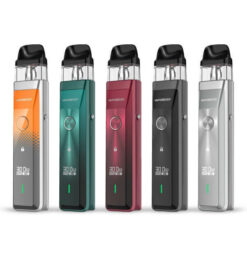Study Highlights Vaping’s Ability to Help Smokers
A recent study has again highlighted the efficacy of e-cigarettes as an effective stop-smoking aid after research showed even those who have no intention to quit are more likely to give up after using a vape device.
The research, published in the Jama Network Open, was carried out by 20 co-authors including Dr. Kenneth Cummings who’s a professor of psychiatry and behavioral sciences at the Medical University of South Carolina, Dr. Andrew Anesetti-Rothermel, a health scientist at the Food and Drug Administration (FDA); and Dr. Heather Kimmel, a health scientist administrator at the National Institutes of Health (NIH).
The study discovered that many people are able to quit smoking after using a vape device – even if they didn’t set out with the intention of doing so.

A Closer Look at the Study’s Findings
The research looked at a group of 1,600 smokers who weren’t planning to quit. Often the heaviest smokers, clearly these are the people most at risk of smoking-related illness.
The participants’ data was taken from the massive Population Assessment of Tobacco and Health (PATH) study carried out a few years ago, and researchers found that those who participated despite having no intention to give up actually saw their quit rate dramatically increase.
This revelation may be ground-breaking. Although we’ve known for years that vape devices are great for helping people who are actively trying to quit, this is the first time anyone has shown that even those who aren’t planning to quit may end up doing so after picking up a vape device.
According to Dr. Andrew Hyland, the chair of health behavior at Roswell Park Comprehensive Cancer Center, the research may be crucial for gaining a full picture of the efficacy of vaping as a cessation tool.
“Most other studies focus exclusively on people who are actively trying to quit smoking, but this study suggests that we may be missing the effects of e-cigarettes by not considering this group of smokers with limited intention to stop smoking—a group that is often at the highest risk for poor health outcomes from cigarette smoking,” he said.

Providing a Clearer Picture
This new research comes on the back of a couple of well-publicised studies in 2020 that attempted to cast doubt on the effectiveness of e-cigarettes. These studies also used data from the PATH research, and the authors of the peer-reviewed papers suggested that vape devices aren’t really helping people quit smoking after all.
These papers first appeared in the American Journal of Epidemiology and looked at both daily and non-daily smokers who attempted to quit between 2015 and 2016. Both studies compared those who used vape devices with those who didn’t and concluded there was no significant difference in success rate.
Since then, many have pointed out the issues with this study. For starters, the time-frame was limited – less than 12 months. It’s common for smokers to relapse, and for some it can take a few attempts before they’ve fully overcome their smoking addiction.
In fact, a study published in Nicotine & Tobacco Research found that those who used e-cigarettes over a longer timeline were much more likely to make a successful quit attempt. This is why a study over a lengthier time-period would have been far more beneficial.
Furthermore, as this latest research highlights, the researchers involved in these two previous studies also ignored an important demographic: those who don’t intend to quit. Thankfully, we now have a robust, well-rounded data set which, as we can see clearly, provides a more complete picture.

Time to Broaden Our Scope
Moving forward, this research could prove pivotal in changing the attitudes of some healthcare professionals, some of whom are still reluctant to accept the benefits of e-cigarettes as a smoking cessation medicine.
Coincidentally, it comes at a time when the NHS looks set to offer vapes on prescription, so hopefully, with another study to add to the ever-growing body of evidence that proves vaping is a relatively safe and effective stop-smoking aid, more will be ready to accept the facts that vaping can and does help people quit smoking.
Moreover, Dr. Raymond Niaura, the interim chair of New York University’s Department of Epidemiology and a co-author on the JAMA Network Open study, also pointed out that the findings should help us view vapes not just as medications, but also as products people can try whenever they feel like it.
“To me, the message here is that if we think of these products within the framework of a smoking cessation medication, then we’re really narrowing the scope of our inquiry.”
“If you think of them as consumer products, where people go back and forth and they try them—and not even because they’re interested in quitting, but something happens along the way, these people end up migrating off cigarettes. The lesson is we need to open our eyes and our minds to what people are actually doing.”

Tips for Using a Vape Device to Quit Smoking
If you’re considering making the switch from smoking to vaping, here are some tips for ensuring your transition is a successful one:
- When you first get started, switching between smoking and vaping and gradually reducing the number of cigarettes you smoke until you’ve completely weaned yourself off cigarettes could make it easier to quit.
- If you enjoyed menthol cigarettes in the past, pick up a menthol flavoured e-liquid as vaping something you’re familiar with should help.
- Don’t beat yourself up if you slip up every now and then. Quitting smoking can be a long and difficult process for some. Relapses are common and as we saw with the study mentioned earlier in this article, sometimes it can take a few attempts. As long as you don’t give up straight away your cravings should subside soon enough.
- Start with a high e-liquid strength. We’d recommend around 10mg for casual smokers and 18-20mg for heavy smokers.
- If you’re finding the stronger e-liquids too harsh but the lower strengths just aren’t quelling those cravings, try nicotine salts. Nic salts are smoother with less “throat-hit” so you can vape stronger e-liquids without any of the coughing and spluttering!
- Reduce the strength of your e-liquid over time. We’d recommend dropping the nicotine strength by 3-6mg every 2-3 months.
- Eventually you should go right down to 0mg nicotine – then the cravings will be gone and it’s time to put down your vape.
- With hundreds of delicious flavours to choose from, some people continue to vape for pleasure, however, most start to forget about their vape as soon as they’re no longer addicted to nicotine.

Starting Your Vaping Journey
So whether you fully intend to quit smoking or not, it’s clear vapes can be beneficial. If you’re keen to start your vaping journey, head over to our Getting Started Guide where you’ll find all the info you need to get you going.
In the guide, we give tips on which device to go for if you’re a beginner (spoiler alert – it’s the Innokin Endura T18-II) as well as helpful information any beginner should find useful such as info on coils, the different types of e-liquid and the various strengths they come in.





